
North Korea: Malnourishment crisis increases for population
We use your sign-up to provide content in ways you’ve consented to and to improve our understanding of you. This may include adverts from us and 3rd parties based on our understanding. You can unsubscribe at any time. More info
Kim Jong-un’s rogue nation held a bizarre military parade today to mark the communist state’s 73rd founding anniversary. Photos showed soldiers marching in hazmat suits as Kim watched on – looking visibly slimmer. Fire engines, tractors, and fireworks were also seen, but no major ballistic missiles were shown off – a notable change from Pyongyang’s military parades.
It comes after Mr Stoltenberg slammed North Korea for wha he said was a violation of arms control rules and advancing nuclear capabilities.
During the 17th NATO conference on arms control and weapons of mass destruction on Monday, Mr Stoltenberg denounced “ignoring or breaking the global rules” and “spreading dangerous technology”.
He added: “NATO’s aim is a world free of nuclear weapons. And we are ready to take further steps to create the conditions for nuclear disarmament negotiations.
“But any meaningful disarmament must be balanced and verifiable.”


He also aimed fire at Russia and China and called for a stronger Non-Proliferation Treaty (NPT) to help enforce global norms against nuclear weapons.
Mr Stoltenberg added: “A world where NATO allies have given up their nuclear deterrent, while Russia, China or countries like North Korea retain their nuclear weapons, is simply not a safer world.”
It came after a UN nuclear agency report said there was evidence that North Korea had restarted a nuclear reactor that is widely believed to have produced plutonium for atomic weapons.
It came following satellite images snapped of the Yongbyon Nuclear Science and Weapons Research Centre.
The report said: “[North Korea’s] nuclear activities continue to be a cause for serious concern.

“Since early July 2021, there have been indications, including the discharge of cooling water, consistent with the operation.
“The new indications of the operation … are deeply troubling.”
The facility, which North Korea calls “the heart” of its nuclear programme, has been the focus of international concerns for decades.
It is unclear exactly how much weapons-grade plutonium or highly enriched uranium has been produced at Yongbyon and where North Korea stores it.
The IAEA has had no access to North Korea since Pyongyang expelled its inspectors in 2009.
DONT MISS
Britain enjoys wine boom amid perfect conditions [REVEAL]
Vaccine breakthrough as study finds only 11% decline in protection [REPORT]
‘Life-saving technology’ praised for reducing fatal car accidents [ANALYSIS]


The country subsequently pressed ahead with its nuclear weapons programme and soon resumed nuclear testing. Its last nuclear test was in 2017.
About 60 miles north of Pyongyang, Yongbyon is home to the country’s first nuclear reactor and is the only known source of plutonium for North Korea’s weapons programme.
Gary Samore, director of the Crown Center for Middle East Studies at Brandeis University, said: “[The IAEA report] appears to indicate North Korea has resumed producing plutonium for its nuclear weapons programme.
“While North Korea already has a significant stockpile of nuclear weapons, this suggests it is moving to expand its current arsenal.”
At a 2019 summit in Vietnam with former US president Donald Trump, North Korean leader Kim Jong Un offered to dismantle Yongbyon in exchange for relief from a range of international sanctio.
Source: Read Full Article